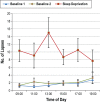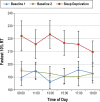The effect of one night's sleep deprivation on adolescent neurobehavioral performance
- PMID: 25364075
- PMCID: PMC4196063
- DOI: 10.5665/sleep.4174
The effect of one night's sleep deprivation on adolescent neurobehavioral performance
Abstract
Study objectives: To investigate the effects of one night's sleep deprivation on neurobehavioral functioning in adolescents.
Design: Participants completed a neurobehavioral test battery measuring sustained attention, reaction speed, cognitive processing speed, sleepiness, and fatigue every 2 h during wakefulness. Baseline performance (defined as those test bouts between 09:00 and 19:00 on days 2 and 3, following two 10-h sleep opportunities) were compared to performance at the same clock time the day following total sleep deprivation.
Setting: The sleep laboratory at the Centre for Sleep Research.
Participants: Twelve healthy adolescents (6 male), aged 14-18 years (mean = 16.17, standard deviation = 0.83).
Measurements and results: Sustained attention, reaction speed, cognitive processing speed, and subjective sleepiness were all significantly worse following one night without sleep than following 10-h sleep opportunities (all main effects of day, P < 0.05). Sleep deprivation led to increased variability on objective performance measures. There were between-subjects differences in response to sleep loss that were task-specific, suggesting that adolescents may not only vary in terms of the degree to which they are affected by sleep loss but also the domains in which they are affected.
Conclusions: These findings suggest that one night of total sleep deprivation has significant deleterious effects upon neurobehavioral performance and subjective sleepiness. These factors impair daytime functioning in adolescents, leaving them at greater risk of poor academic and social functioning and accidents and injuries.
Keywords: adolescence; attention; cognition; sleep; sleepiness.
Figures







Similar articles
-
Neurobehavioral dynamics following chronic sleep restriction: dose-response effects of one night for recovery.Sleep. 2010 Aug;33(8):1013-26. doi: 10.1093/sleep/33.8.1013. Sleep. 2010. PMID: 20815182 Free PMC article. Clinical Trial.
-
Cognitive workload and sleep restriction interact to influence sleep homeostatic responses.Sleep. 2014 Nov 1;37(11):1745-56. doi: 10.5665/sleep.4164. Sleep. 2014. PMID: 25364070 Free PMC article. Clinical Trial.
-
The effect of split sleep schedules (6h-on/6h-off) on neurobehavioural performance, sleep and sleepiness.Appl Ergon. 2016 May;54:72-82. doi: 10.1016/j.apergo.2015.12.004. Epub 2015 Dec 21. Appl Ergon. 2016. PMID: 26851466
-
Neurobehavioral Effects and Biomarkers of Sleep Loss in Healthy Adults.Curr Neurol Neurosci Rep. 2017 Sep 25;17(11):89. doi: 10.1007/s11910-017-0799-x. Curr Neurol Neurosci Rep. 2017. PMID: 28944399 Review.
-
Effects of sleep deprivation on cognition.Prog Brain Res. 2010;185:105-29. doi: 10.1016/B978-0-444-53702-7.00007-5. Prog Brain Res. 2010. PMID: 21075236 Review.
Cited by
-
An exploratory study of sleep habits in school-aged survivors of retinoblastoma.Sleep Med. 2023 Mar;103:123-130. doi: 10.1016/j.sleep.2023.01.026. Epub 2023 Feb 2. Sleep Med. 2023. PMID: 36780752 Free PMC article.
-
Current situation and factors influencing physical fitness among adolescents aged 12 ∼ 15 in Shandong Province, China: A cross-sectional study.Prev Med Rep. 2023 Oct 12;36:102460. doi: 10.1016/j.pmedr.2023.102460. eCollection 2023 Dec. Prev Med Rep. 2023. PMID: 37927974 Free PMC article.
-
Cognitive throughput and working memory raw scores consistently differentiate resilient and vulnerable groups to sleep loss.Sleep. 2021 Dec 10;44(12):zsab197. doi: 10.1093/sleep/zsab197. Sleep. 2021. PMID: 34333658 Free PMC article.
-
Alcohol use severity and the neural correlates of the effects of sleep disturbance on sustained visual attention.J Psychiatr Res. 2021 Oct;142:302-311. doi: 10.1016/j.jpsychires.2021.08.018. Epub 2021 Aug 16. J Psychiatr Res. 2021. PMID: 34416549 Free PMC article.
-
Physical fitness status and influencing factors among college students aged 19 ~ 22 in Shandong province, China: a cross-sectional study.BMC Public Health. 2025 Jun 5;25(1):2105. doi: 10.1186/s12889-025-22350-x. BMC Public Health. 2025. PMID: 40474138 Free PMC article.
References
-
- Paus T. Mapping brain maturation and cognitive development during adolescence. Trends Cogn Sci. 2005;9:60–8. - PubMed
-
- Lerner R. Adolescent maturational changes and psychosocial development: A dynamic interactional perspective. J Youth Adolesc. 1985;14:355–72. - PubMed
-
- Calamaro CJ, Mason TB, Ratcliffe SJ. Adolescents living the 24/7 lifestyle: effects of caffeine and technology on sleep duration and daytime functioning. Pediatrics. 2009;123:e1005–10. - PubMed
Publication types
MeSH terms
LinkOut - more resources
Full Text Sources
Other Literature Sources
Medical

